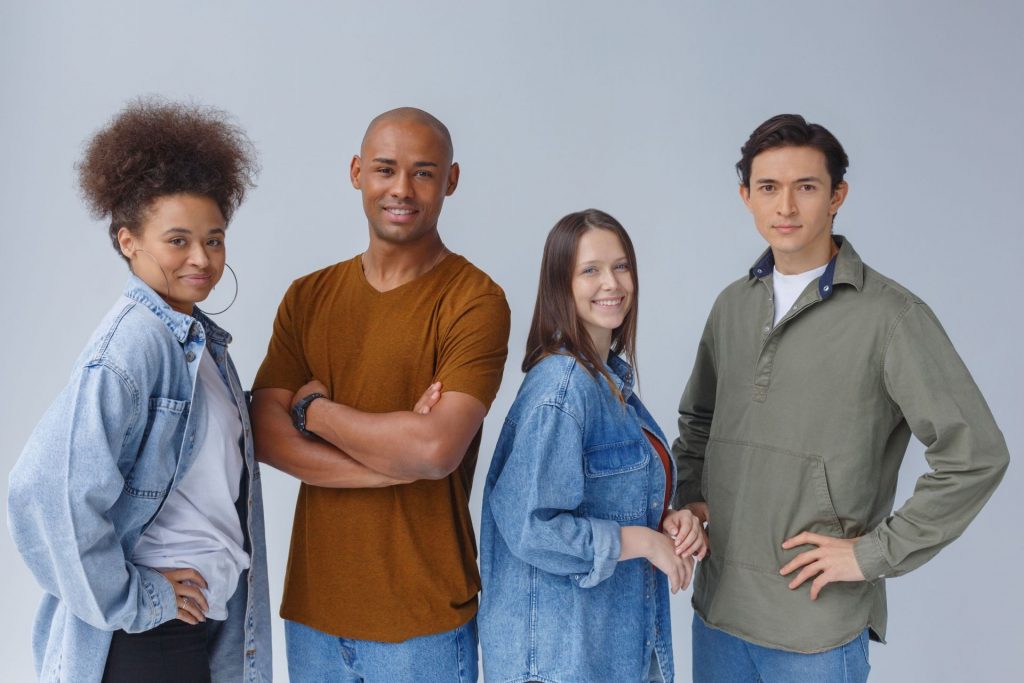Table of Contents
Why Do We Need to Embrace Diversity in Design?
Unlike what everyone believes, diversity isn’t a hindrance but a way to amplify our design. Today, there are many ways that diversity is used in the design. From the website hero image that’s used in displaying confidence, or a group of individuals who are working towards a common goal, to the smiling face of people celebrating and full of hope and optimism.
Each of these is an attempt to include a subject from a different race or culture, and it explains why most designers choose these types of images. You might think these designers are only seeking to be representational or cover different bases, but the reality is that they are only extending different cliches across different groups of people and individuals.
One of the most noticeable things today, even among most companies, is that they all seek to include the images of different communities worldwide, especially in their marketing materials and campaigns. The need to provide diversity in design and even in photography is a continuously expanding and growing topic that different photography communities are debating today, especially with regards to its use in the marketing and advertising industry. Diversity in design is a key topic that needs to be addressed, and that’s what we seek to achieve in this article.
The meaning of diversity is different for everyone, but here’s a quick way to decide what it actually means. These are some of the elements you might want to consider when you are selecting a place, scenario, or person to photograph.
- Cognitive Diversity: This includes the approach that people use when thinking
- Experiential Diversity: Individual abilities, hobbies, and affinities
- Demographic Diversity: Including sexual orientation, race, or gender.
These elements all work together to shape and define our identities. Diversity in design or photography, therefore, implies creating imagery that can serve as a perfect reflection of different features that define an individual. This is why photographers across the world are advised to place their focus on diversity in design to ensure that they can showcase authentic content.

It is worth mentioning that photography is a tool that helps designers to eliminate stereotypes and explore different social issues requiring serious attention. When correctly used, it makes it easier to break different barriers, especially those that relate to regional and cultural issues.
This is part of the main reasons why at photoAC, we ensure that all the images and contents available on our platform are diverse, and this allows us to effectively deliver to different communities in over 100 countries and also provide free diversity images.
Choosing Diversity in Design and Photography
Selecting the photo to use in your brand is more of a thoughtful and deliberate process and is a key factor that can make any culture more equitable. A lot of people may not know this, but photographers are powerful, and they play a very significant role in our world today. When you look on the internet today, you’ll see various photos on different websites, social media platforms, and even on television.
These photos we see in the media have helped in creating and defining different standards today, as well as what’s normal, valuable, and good. However, one noticeable thing about the media is that there are a few biases, making it not completely inclusive for everyone. In addition to these biases, there are also stereotypes and prejudices that have been transferred across different generations. As a result, most of the images today don’t completely depict the actual reality of things.
You might have already noticed that most pictures today feature Caucasian people, who are mostly able-bodied, straight, attractive, and young. Also, if these images are to portray heroism, leadership, power, and strength, the main subject in the image is mostly male. However, we don’t all fit this description, and we are in fact, more diverse than what’s presented. What’s conventional is for white people to be used as main characters while others as a minority, especially underrepresented groups, women, and people with disabilities.
Also, most of the marketing images you’ll find, especially in pop culture, like clothing, cartoons, music groups, movies, and TV shows, mostly include white people as the main focus. When we see these images most of the time, it tends to change our perspectives about the world, especially with respect to who is important and who is not important.
With that in mind, when choosing diversity in design, it’s important to ensure that you not only learn but also recognize these biases to help you easily interrupt them. It’d help you a lot to also consider checking different demographic checklists, including races/ethnicities, ages, genders, body types, and abilities. After doing that, you also need to ask yourself certain questions just to ensure that you do not introduce any form of bias.
Always pay attention to photo composition, cropping, and lighting when taking these pictures, and if you plan to use stock photo websites for free diversity images, we advise that you use a more diverse and inclusive website like photoAC.
How to Include Diversity and Inclusion to your Design
We have said a lot about diversity in design and the role of free diversity images. However, you also need to know the best way to include diversity and inclusion in your design. But how do you go about that aspect? That is what we will take a look at in this section, so continue reading.
It is worth mentioning that photos are not the only set of things that keep brands limited, outdated, and stagnant. However, these steps below will help you to easily help your brand to acknowledge the underrepresented and marginalized individuals.

Photography
Stock Photos
One of the reasons for capturing images is mostly related to obtaining a guide. With images, you can easily set a norm, meaning, or more, and by sticking to the conventional and stereotypical representations, we would only end up reinforcing a sense of insincerity and mediocrity, which is not what we want to achieve. The good thing is that there are different ways for designers to create better photo choices, especially when it comes to diversity in design and inclusion.
Since the aim is for complete inclusion, you may easily fall into the stereotypical imagery, but this can be avoided with the aid of stock images platforms. The good thing about these sites is that they display reality, and most of them understand the essence of diversity in design.
As mentioned earlier, there are different stock image websites with free and affordable images for people to use, and these images are obtained from a myriad of backgrounds, abilities, sexualities, genders, ethnicities, and races. Also, the creators of these images have, through time, put in great efforts towards ensuring more diverse and inclusive images. When you go through the collections of these sites, you’ll gain a better understanding of what these diverse photos are all about.
If you are looking for a stock images site where you can find free diversity images, you might want to consider checking photoAC. With the images on photoAC, you won’t have to worry about the conventional stereotypical representations mentioned above. This is because these images are taken with diversity and inclusion in mind.

Alt-text
With respect to photography, another way you can include diversity and inclusion in your design is through alt-text. This is an important tool that helps in passing messages across to different audiences, especially those who are visually impaired or those who decide to download the images.
There’s a field created for designers to write a description for social media and email. These alt texts are usually the default name of these images, but when using them, it’s always best to provide a little explanation for readers to visualize effectively.
Color
ADA Compliance
A lot of designers like to go beyond their limits, especially when using colors. People like to use different hues, grayscale, tones, monochromes, and combinations in every design. However, it’s almost advisable to utilize Web Content Accessibility Guidelines (WCAG), even though you don’t necessarily need to. With this, you can be sure that you’re on the right track.
Dark Mode
A lot of people tend to align toward dark mode in apps and websites, but it’s worth mentioning that the best way to apply the dark mode is by paying attention to obvious inversions and sticking to the WCAG guidelines for compliance and to maintain color balance.
Words
With the way people from different speaking countries are dispersed across different parts of the world, the need for a way to translate languages cannot be overemphasized. You might be tempted to use just any type of translation tool or even Google Translate, and even though these tools are really helpful, they still have certain flaws. The best thing is to hire a translation service to help you handle the translation effectively. Fortunately, there’s a myriad of options that you can use for this purpose, and it ranges from actual human translators to automated bot scanners.
Sound
For sounds, it’s usually best to include closed captioning and transcripts to the sounds you use. Even though there are so many platforms offering free closed captioning, it’s usually forgotten and not utilized by many. Therefore, when creating sound, always remember to include some transcripts so that your audience has captions that they can read if they want to turn down the volume. The need for captions and transcripts cannot be overemphasized, and you should add them to your sound.
Adopting an Inclusive Mindset
It’s usually faster and easier for designers to use images that don’t actually depict what it means to be inclusive. However, there’s a great benefit to enjoy not only for organizations but also for our culture as a whole, but this can only be possible when we use these images in more conscious, careful, and thoughtful ways.
Images have a seamless way of leaving an impact on our view of the world. However, a lot of media professionals tend to ignore how important this is, and they don’t spend much time on images as they would on words. In some cases, this may be due to lack of money or even time, as most photographers are looking for ways to save costs and cut down on expenses.
One thing to always remember is that you should have your audience in mind and remember that they will appreciate it if you make your designs more dynamic, interesting, and engaging.
We’ve put several tips above to guide you through choosing free diversity images, and you only need to start trying. The bottom line is that you need to be ready to take the extra time for each photo selection process and ensure that you there’s some level of diversity in your designs. There are several questions that you should ask yourself to help you fill in gaps. Pay attention to the opportunities for minorities and basically act as a protagonists when taking or finding images. The moment you find a photo you think you like, you can ask for other people opinions of the picture and see what they think of the picture.
The goal is to disprove stereotypes, which is why you should ensure you choose interesting and unexpected photos that can easily disprove these stereotypes. In the long run, you’ll be excited that you fully embraced diversity in design; the free diversity images on photoAC will always come in handy for you.
